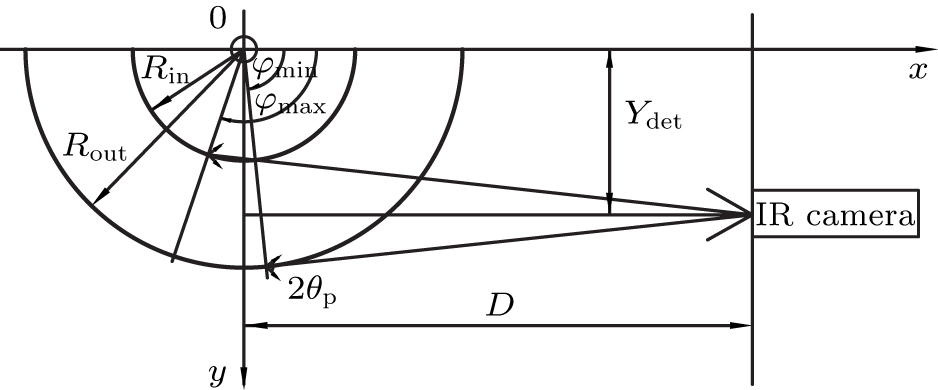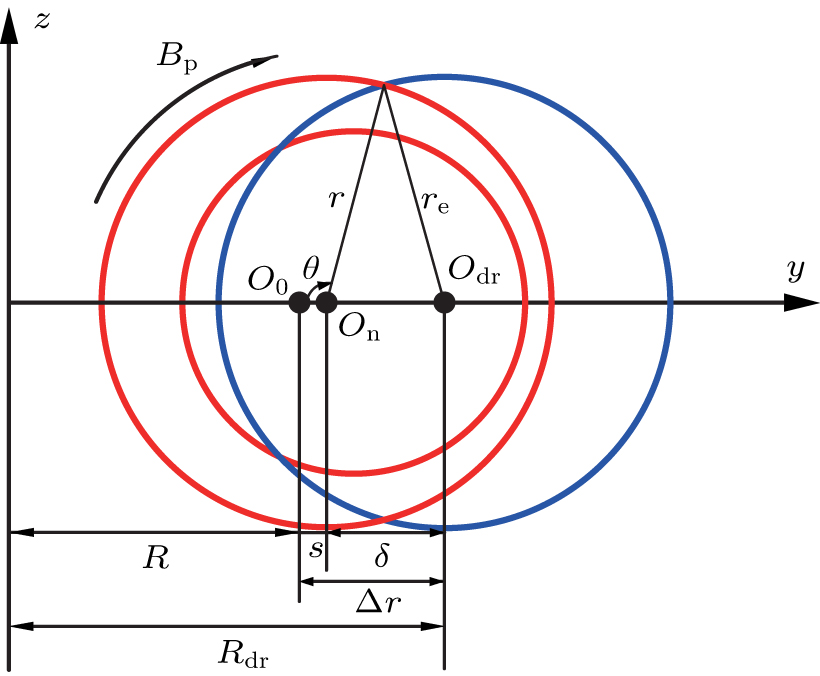† Corresponding author. E-mail:
A detailed analysis of the synchrotron radiation intensity and energy of runaway electrons is presented for the Experimental Advanced Superconducting Tokamak (EAST). In order to make the energy of the calculated runaway electrons more accurate, we take the Shafranov shift into account. The results of the analysis show that the synchrotron radiation intensity and energy of runaway electrons did not reach the maximum at the same time. The energy of the runaway electrons reached the maximum first, and then the synchrotron radiation intensity of the runaway electrons reached the maximum. We also analyze the runaway electrons density, and find that the density of runaway electrons continuously increased. For this reason, although the energy of the runaway electrons dropped but the synchrotron radiation intensity of the runaway electrons would continue rising for a while.
In tokamaks, electrons mainly experience two forces, one is the electric field force Fe that can make the electrons accelerate, and the other is the force of collisions with the plasma particles that can decelerate the electrons

With the increasing volume of tokamak devices, the energy of runaway electrons is getting higher and higher. In future tokamaks such as ITER, the energy of runaway electrons can even reach 100 MeV.[4] Such high energy electrons can be a serious threat to the tokamak.[5] To study the energy and intensity evolution of these high-energy runaway electrons in experiments, it is extremely important to diagnose the electron parameters effectively and correctly.
In general, the generation of runaway electrons can be divided into two categories: one is in the current ramp-up phase, and the other is during the fast plasma terminations due to plasma disruptions or the killer pellet injection.[6] The runaway electrons generated in fast plasma terminations have a short duration and change rapidly. The frame frequency of the infrared cameras existing on the EAST is low. It is difficult to study the change of runaway electrons. However, the infrared camera can be used to study the evolution of runaway electrons in the current ramp-up phase.
The typical method is measuring the thick-target bremsstrahlung emission or photoneutrons resulting by runaway electrons when they are lost and then impact the limiter or vessel structures. Detection of the synchrotron radiation emitted by runaway electrons by infrared cameras is the best way to diagnose the high-energy runaway electrons which were constrained in the core of the plasma directly.[7] In the current ramp-up phase, the vast majority of high-energy runaway electrons are constrained in the core of the plasma, only a small part of the runaway electrons lost and impact the limiter or vessel structure. In simple terms, detecting the runaway electrons by an infrared camera can reflect the situation of the runaway electrons existing in the plasma better.
In this paper, we carry out detailed analysis of the synchrotron radiation intensity and energy of runaway electrons in EAST. In Section
It is generally defined as 


Schematic of the relative positions of the beam of runaway electrons and the infrared camera is shown in Fig. 
 | Fig. 1. Relative position of the beam of runaway electrons and the infrared camera in the plane z = 0. Rin and Rout are the inner and outer major radii of the beam. |
The analytical treatment of the calculation of the synchrotron radiation spot shape from the runaway electrons has been carried out in Ref. [8]. The coordinates we used in the calculation are shown in Fig.
All the subsequent analyses of the runaway electrons appeared in current ramp-up phase are based on the discharge shown in Fig.
 | Fig. 3. Time slice of a runaway discharge in EAST. The waveforms are the plasma current, loop voltage, line-averaged density, RA, power of 2.4 G and 4.6 G lower hybrid wave. |
Under the above infrared camera and runaway electron beam position conditions, the synchrotron radiation emitted along the runaway electron velocity vector falls into the infrared camera whose conditions satisfy the following equation:[8]









As shown in Fig.
 | Fig. 4. Synchrotron radiation spot from the runaway electron beam recorded by the infrared camera in EAST. |
The energy of the runaway electron beam can be gained from its drift orbit shift. The drift orbit shifts from the magnetic surface by a distance δ, to the first-order approximation,[9]








 | Fig. 6. Synchrotron radiation spot from the runaway electrons beam in EAST. 
|
 | Fig. 7. The evolution of the synchrotron radiation spot emitted by the runaway electrons. The corresponding moments are (a) 1.46 s, (b) 1.52 s, (c) 1.58 s, (d) 1.64 s, and (e) 1.70 s. |
As shown in Fig.
The synchrotron radiation intensity of the runaway electrons recorded by the infrared camera at pixel A is shown in Fig.
 | Fig. 9. Relationship between the synchrotron radiation intensity, energy, and density of the runaway electrons. They do not reach their maxima at the same time. |
In Fig. 

The density of the runaway electrons can be calculated by the synchrotron radiation intensity recorded by the infrared camera and the synchrotron radiation spectra of single runaway electron (Fig. 



Synchrotron radiation is a powerful tool for diagnosing high-energy runaway electrons that are confined in the core of the plasma. In this paper, we have presented a detailed analysis of the energy, synchrotron radiation intensity, and density of the runaway electrons.
The energy of the runaway electron beam can be gained from its drift orbit shift. The energy of the runaway electrons rose before 1.48 s and then decreased. The decrease of the runaway electron energy is due to the increase of the plasma density, which leads to the increase of drag and the decrease of loop voltage, resulting in the decrease of power.
The synchrotron radiation intensity of the runaway electrons recorded by the infrared camera and the energy of the runaway electrons did not reach their maxima at the same time. The main reason why they did not reach the maximum at the same time is that the density of the runaway electrons was rising when the energy of the runaway electrons began to decrease. The increase of the runaway electrons density led to the synchrotron radiation intensity recorded by the infrared camera increasing though the energy of the runaway electrons decreased.
| [1] | |
| [2] | |
| [3] | |
| [4] | |
| [5] | |
| [6] | |
| [7] | |
| [8] | |
| [9] | |
| [10] |








